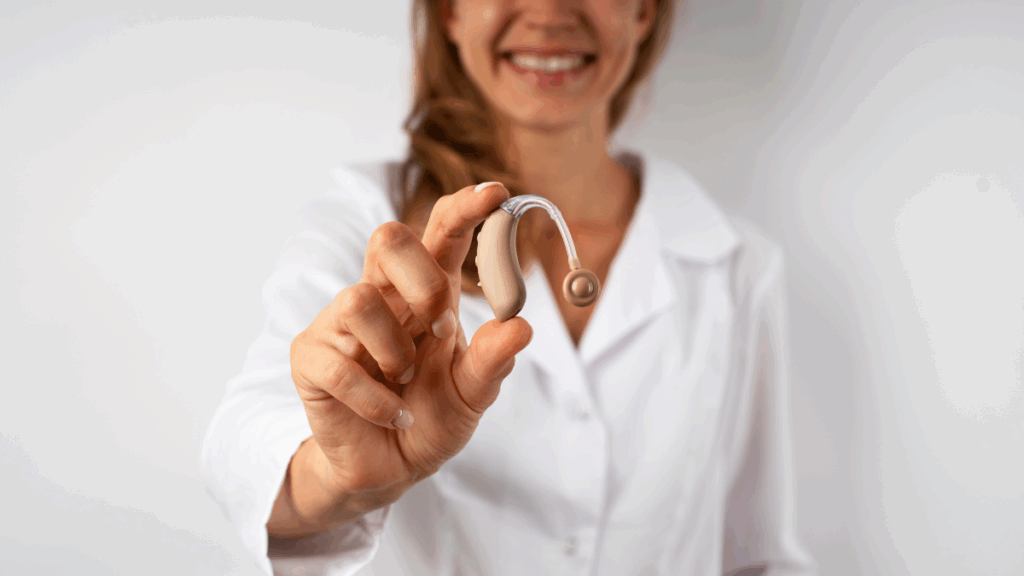
Introduction to Hearing Aids: What You Need to Know
Hearing aids benefit millions by giving people worldwide improved life quality despite their widespread loss. Learning about hearing aids’ functionality becomes essential because it directly affects decision-making for new users or people who need to choose a device for themselves and their loved ones.
This guide will walk you through hearing aid functions alongside an examination of various hearing aid kinds and maintenance practices that extend hearing aid effectiveness.
What Are Hearing Aids?
A hearing aid is a small electronic device meant to amplify sounds. Hearing aids are worn in or behind the ear, such that individuals who have a loss of hearing can make sounds louder and clearer. It basically functions to collect sounds from the environment, amplify the sound, and then deliver it to the ear canal.
They are used for all types of hearing losses, especially for those individuals who have problems hearing in noise or probably have some problems understanding speech. A hearing aid makes sounds clear and, therefore, enhances communication and enables more people to live more closely with the people around them.
Types of Hearing Aids
Common Types of Hearing Aids and Their Specialized Use Behind-the-Ear (BTE) Hearing Aid Design: These sit behind the ear while connected with a plastic earmold that fits inside the ear canal.
Behind-the-ear (BTE) Hearing aids
- Design: BTE hearing aids sit behind the ear and connect to the ear with a thin tube.
- Best for: People who have mild to profound deafness.
- Pros: They are more powerful, appropriate for severe losses, and can be more easily adjusted.
- Cons: Slightly larger, may be less discreet.
Completely in-Channels (CIC) Hearing Aid Design:
- Design: Now, CIC hearing aids fit instead of earplugs far into the ear canal, resulting in invisibility.
- Best For: Those will have mild to moderate deafness.
- Pros: In addition, they present less visibility, comfortable for most users.
- Cons: Aspers, as well as lesser power because of their smaller size, might affect the battery life and some features.
Receiver-in-Canal (RIC) Hearing Aids
- Design: An RIC hearing aid features a tiny receiver that is placed deep inside the ear canal, while the hearing aid body rests discreetly behind the ear.
- Best For: Mild to moderate hearing loss.
- Pros: Better sound quality than traditional BTES and more discreet than BTE models.
- Cons: Regular cleaning of the receiver is necessary.
Invisible-in-Canal-Hearing Aids
- Design: IIC hearing aid features the smallest type of hearing aid, slightly deep into the ear canal, and is nearly invisible.
- Best For: Mild to moderate hearing loss.
- Pros: Extremely discreet and comfortable for daily wear.
- Cons: Limited battery life and fewer features.
Rechargeable Hearing Aids
The market preference for rechargeable hearing aids has increased recently because their usefulness and green advantages appeal to modern consumers. The devices operate with rechargeable integrated batteries rather than standard disposable batteries. Rechargeable hearing aids solve the replacement battery problem because users can fully charge them by simply plugging them in during the night.
Benefits of Rechargeable Hearing Aids:
- Cost-effective: Users do not spend money on replacing disposable batteries when they possess rechargeable hearing aids.
- Eco-Friendly: Reduces battery waste.
- Convenient: Customers benefit from recharging the devices easily without the hassle of small and hard-to-handle batteries.
Choosing the Right Hearing Aid
Choosing the right hearing aid for oneself is just a little too tough, but after taking into account the following important factors, one could find it easier:
- Hearing Loss Severity: The degree of hearing loss will usually determine the type of hearing aid that is best suited for an individual. A less powerful and smaller hearing aid could work well for mildly impaired hearing, while a larger and more powerful model could be required for someone with a more significant loss.
- Lifestyle: Think of daily activities. Are you exposed to too much noise at work, or do you socialize mostly in loud places? If the answer is yes, it means a hearing aid that features noise reduction and a connectivity device might just cut it.
- Budget: Hearing aids vary greatly in price. Generally, the more advanced models are more expensive due to premium features such as Bluetooth connectivity or rechargeable batteries. It is, therefore, best to determine what is important for you and balance the cost against that requirement.
- Type of Appearance That One Prefers: Hearing aids come in many different sizes and designs, with some people preferring their devices to be discreet, whereas some have no qualms if it’s a visible model of a hearing aid. Select one that puts the wearer at ease.
Technology Behind Hearing Aids
The hearing aid technology has undergone rapid improvements within the past decade and the newer models come with improved sound quality and ease of use.
- Noise-Cancelling: Noise-cancelling technology minimizes background sounds or noise, thus making it easier to listen to speech in loud environments.
- Bluetooth Connectivity: Some hearing aids can synchronize with mobile devices and computers to enable users to stream music, phone calls, or other kinds of audio directly into the hearing aid.
- Customized Modality: With many hearing aids, an individual can pre-program their audiological adjustment capabilities in personalized settings for different environmental cues. This means that the user may customize the volume levels or activate several features for use in different locations.
Maintenance and Care of Hearing Aids
To keep hearing aids functional for years, they should be regularly maintained. Some tips on the maintenance of hearing aids include the following:
- Clean your hearing aids daily: Clean your hearing aids daily, preferably with a soft, clean cloth, which can help ensure that the earwax and dirt are cleared from the hearing aids.
- Replace filters regularly: These filters tend to keep earwax out of the device itself.
- Store your hearing aids properly: Keep hearing aids well stored, such as in a dry case, while not in use.
- Avoid moisture: Remove your hearing aids before you take a shower or go swimming.
Conclusion
Choosing the correct hearing aid is an important choice that will strongly affect your lifestyle. Your decision about which hearing aid to select depends on understanding their features because different types of hearing aids serve distinct hearing needs and personal preferences. Remember to consult an audiologist to ensure the most suitable device for your hearing loss level and lifestyle.
Frequently Asked Questions
BTE or Behind-The-Ear hearing aids are most effective for severe hearing loss because they provide strong amplification with a comfortable fit.
With proper care, hearing aids last 3-5 years because regular cleaning and maintenance extend their lives.
The benefits of rechargeable hearing aids include convenience, the absence of using disposable batteries, and the ability to be eco-friendly and cost-effective.
Some hearing aids have features to mask tinnitus sounds; for more options, speak to your audiologist if this is a concern.
If you find it hard to hear in any situation, such as speaking or when trying to listen to the TV, it would be best to go consult an audiologist for a hearing test.
Dr. Harshi, is an accomplished Audiologist with extensive expertise in treating individuals with hearing impairments.

